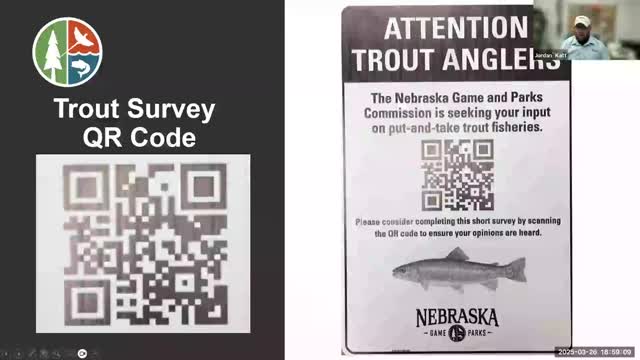Fisheries official explains Sherman and Mac dam closures during walleye spawn
January 01, 2025 | Nebraska Game and Parks Commission (NGPC), State Agencies, Organizations, Executive, Nebraska
This article was created by AI summarizing key points discussed. AI makes mistakes, so for full details and context, please refer to the video of the full meeting. Please report any errors so we can fix them. Report an error »

The Nebraska South-Central District Fisheries Meeting held on January 1, 2025, focused on key issues affecting local fisheries, including dam closures during the walleye spawn and the management of invasive species.
One of the primary discussions centered around the closure of the Sherman Dam during the walleye spawning season in April. This closure, which has been in place since the 1980s, was implemented due to concerns about illegal activities at the dam. The closure lasts from April 1 to April 20, coinciding with the peak of the walleye spawn. Fisheries biologists explained that Sherman serves as a brood lake for walleye production, making it essential to limit angler activity during this critical period. However, they noted that fishing is allowed before and after the closure, indicating that it is not a complete shutdown.
In contrast, the biologists discussed why other locations, such as McConaughy, do not have similar restrictions. Data from recent creel surveys indicated that fishing during the spawn at McConaughy has minimal impact on the walleye population. The surveys showed that most anglers follow regulations and often release large female fish, leading to the decision to keep the dam open to provide fishing opportunities for those without boats.
The meeting also addressed the presence of invasive species, particularly milfoil, in several local lakes, including Buffelhead and Cotton Mill Lake. The fisheries team is actively sampling vegetation in these areas to better understand the extent of the issue.
Additionally, the meeting highlighted the expected strong wiper fishing in Harlan Reservoir, with anglers encouraged to fish from shore during the peak season in April and May. The biologists reported a healthy population of wipers, particularly from the 2021 year class.
Lastly, the introduction of muskies into various lakes was discussed, with established populations noted in Mormon Island and Sandy Channel. The fisheries team emphasized the importance of maintaining a proper prey base to support these predator fish.
Overall, the meeting underscored the balance between managing fish populations and providing recreational opportunities for anglers in Nebraska's South-Central District. The discussions will inform future fisheries management strategies and ensure sustainable practices moving forward.
One of the primary discussions centered around the closure of the Sherman Dam during the walleye spawning season in April. This closure, which has been in place since the 1980s, was implemented due to concerns about illegal activities at the dam. The closure lasts from April 1 to April 20, coinciding with the peak of the walleye spawn. Fisheries biologists explained that Sherman serves as a brood lake for walleye production, making it essential to limit angler activity during this critical period. However, they noted that fishing is allowed before and after the closure, indicating that it is not a complete shutdown.
In contrast, the biologists discussed why other locations, such as McConaughy, do not have similar restrictions. Data from recent creel surveys indicated that fishing during the spawn at McConaughy has minimal impact on the walleye population. The surveys showed that most anglers follow regulations and often release large female fish, leading to the decision to keep the dam open to provide fishing opportunities for those without boats.
The meeting also addressed the presence of invasive species, particularly milfoil, in several local lakes, including Buffelhead and Cotton Mill Lake. The fisheries team is actively sampling vegetation in these areas to better understand the extent of the issue.
Additionally, the meeting highlighted the expected strong wiper fishing in Harlan Reservoir, with anglers encouraged to fish from shore during the peak season in April and May. The biologists reported a healthy population of wipers, particularly from the 2021 year class.
Lastly, the introduction of muskies into various lakes was discussed, with established populations noted in Mormon Island and Sandy Channel. The fisheries team emphasized the importance of maintaining a proper prey base to support these predator fish.
Overall, the meeting underscored the balance between managing fish populations and providing recreational opportunities for anglers in Nebraska's South-Central District. The discussions will inform future fisheries management strategies and ensure sustainable practices moving forward.
View full meeting
This article is based on a recent meeting—watch the full video and explore the complete transcript for deeper insights into the discussion.
View full meeting
